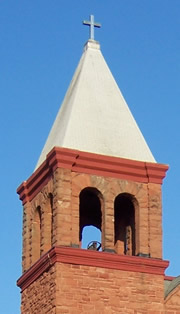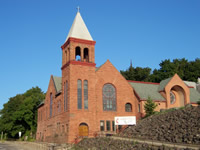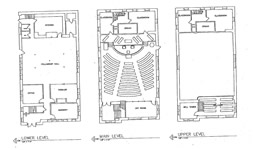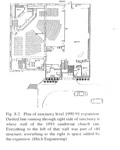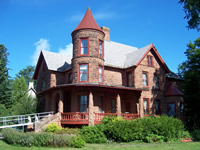Grace United Methodist Church The first Grace United Methodist Church was built in 1854, brought about by a group of Methodists known as the Portage Lake Class. It was a single-story wood-frame structure with no basement. In the late 1880s and early 1890s the church experienced a steady increase in membership and needed to accommodate the increasing amount of people. In 1892 and 1893 the old structure was torn down and the new one erected on the same location at the corner of Isle Royale and Montezuma. In 1892 Pryor submitted plans for the new Grace United Methodist Church. The decision to use his plans may have been influenced by his family’s connections to the church. The building was finished in early 1893.6 The Richardsonian Romanesque building cost $18,000.7 The Jacobsville sandstone building has large, round-arched windows with stained glass and a substantial corner tower. The new structure had a basement which included a kitchen, boiler room, Sunday school room, and a social area. The main level contained the sanctuary and meeting rooms. The main level had two entrances; one through an interior stairway in the tower, and an exterior staircase. One distinctive feature of this building is the stained-glass windows. On November 24, 1916, a fire in the church destroyed the interior. The Maass Brothers, architects, undertook designs for the reconstruction, which made some modest changes to the original building. Maass eliminated indentations to produce a rectangular plan, extended the building toward the rear, and eliminated the exterior stairs.8 Due to lack of funds the church was not finished until 1928. Even with the fire and remodeling, the congregation was able to retain the large stained-glass window. In 1969-71 a fire escape was added to the east and a cry room was added to the back of the sanctuary.9 In 1979, a handicapped entrance was added to the building. In 1990-91 the congregation undertook the latest addition to the church, expanding the sanctuary to the south in concrete of the same color as the sandstone. On June 30, 1991, the $650,000 addition, constructed by Thomas Moyle, was complete.10
Roehm House Paul P. Roehm (1857-1925) was a contractor and coal dealer, but this house exhibits another of his lines of work, and that was masonry. A rare example of a Jacobsville sandstone house, this is a particularly ornate one. The three-story, round corner tower is the most distinguishing feature. A verandah curves around it, supported by stone columns. A rounded bay is labeled "conservatory" on the plan. Besides that room, the first floor has a parlor (with the corner tower), a sitting room, large reception hall, dining room, and a first-floor bedroom with attached bathroom. The kitchen is equipped with a pantry and china closet. The second floor has six bedrooms and one bathroom.11 Roehm was a successful businessman, responsible for the construction of many of the buildings that appear on this website. He invested in mining companies, notably the Calumet & Montana and the Wolverine & Arizona.12 He was a charter member of the Miscowaubik Club and was a director of the Merchants' and Miners' Bank.13 In 1879 he married Anna MacDonald and they had seven children who lived to adulthood.14 His oldest daughter, Algenore, worked as a stenographer in the family business but after attending the University of Michigan she moved to Milwaukee to work as a schoolteacher.15 In 1910, the other six children, ranging in ages from 13 to 26, were living at home.16
|
